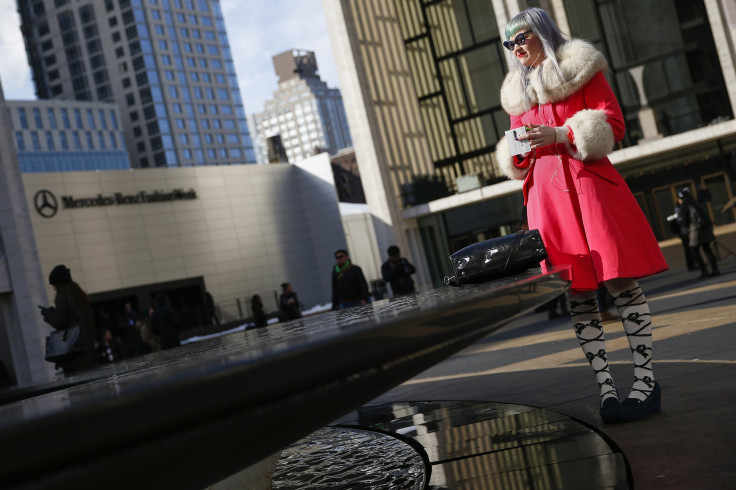Sartorial Shadow Cast Over New York Fashion Week With Mass Changes, Chaos And Confusion

Let's just say it's icier inside New York Fashion Week than outside in the frigid February weather, and we're not talking about temperature.
While this is normally a time to celebrate the latest collections, and the designers who create them, there was a large sartorial shadow cast over the first day of fashion’s big week for the Autumn/Winter 2014 season. The usual feeling of excitement at The Tents, as they are called, at Lincoln Center, where Mercedes-Benz sponsors a unified event space, is rife with confusion and overall chaos this season. As the milieu surrounding the event is rapidly changing and designers are showing elsewhere independently, are these changes an upgrade of progress for the bi-annual event or a downgrade into extinction?
“It's a lot different,” Couture Press contributor Maria Bloem told the International Business Times on Thursday, the first of seven days. “It was less intimate, less personal. It's very strict.”
Since the event's inception at Lincoln Center in 2010, high-profile buyers, designers and press have been growing increasingly tired of The Tents' lack of cachet, prompting designers to ditch the notion of holding their shows at the centralized location and to opt for event spaces with more stature and intimacy. IMG, the company that produces Fashion Week, responded by announcing in December that it will make Fashion Week more exclusive, revamping its spaces and tightening guest lists.
"It was becoming a zoo," said Catherine Bennett, senior vice president of IMG Fashion, adding to The Wall Street Journal that Fashion Week went from a gathering of “established designers” and “select media and buyers” to “cluttered” and “exhausting.”
“You could tell it is more exclusive,” Bloem said of this season. “There are less people roaming around and whatnot.”
There are even noticeably fewer IMG staffers roaming on location at Mercedes-Benz Fashion Week, causing mass confusion for many attendees unfamiliar with the new adjustments.
“It’s very confusing and it’s very unorganized at the front desk,” blogger BJ Panda Bear, who is covering the shows for Fault Magazine, said. “It’s usually more speedy and more clear.”
The confusion at The Tents is mimicking the partisan stalemate sometimes seen in politics; IMG zigged and the fashion world zagged. Despite the consistent number of showings at The Tents at 69 — a far cry from the majority all over the city, many of the most revered designers like Diane von Furstenberg and Michael Kors have decided to skip Lincoln Center altogether, making it more of an afterthought than an epicenter.
Now, the “hub” of Fashion Week has turned into a ghost town, with fewer frequenters than ever in recent years, as the fashion flock head south to venues chosen by the elite all over the city. Heavy hitters like von Furstenberg and Kors opted for Spring Studios, a new event space at 50 Varick St. in Tribeca. Others will use West Chelsea's Eyebeam and Milk Studios, while the hottest ticket in town, Alexander Wang, will be at the Brooklyn Navy Yard — yes, in an outer borough— setting off panic for editors who typically don’t leave the island of Manhattan.
Still, some will do anything for fashion.
“It's fine,” BJ Panda Bear said about traveling uptown and downtown for the next seven days, which he does for the sake of art. “Each designer has their own aesthetic, and certain venues are fitting.”
It's not that attendees want to spend endless dollars on cab fare; the shuttling, from the New York City traffic to the endless pits of sludge and slush from the recent snowfall, is actually becoming an occupational hazard.
“I'm not going to those,” Bloem said of the downtown spaces. “It's cold. It's freezing. Who wants to be traveling around like that?”
Not to mention that editors, bloggers, buyers and stylists who wish to attend the shows of the last men standing at Lincoln Center are forced to pick and choose among the swanky downtown venues or The Tents. And since the purpose of Fashion Week is exposure, which translates into sales, business will undoubtedly be affected by lulls in attendance.
“It’s like the Wild, Wild West again, like before we even had the tents at Bryant Park,” Adam Glassman, creative director of O, the Oprah Magazine, told the New York Daily News earlier this month, reminiscing on the early days when there was more centralization.
That disarray prior to 1993, when designers still showed their collections all over town, prompted members of the Council of Fashion Designers of America, the organization which teams with Vogue magazine to preside over the industry, to craft a plan for a more streamlined Fashion Week. With Bryant Park chosen for its proximity to the Garment District, the point was to make it easier to review many shows in a short time span. But, since it's fashion, what's in style one season is out the next.
“It’s going to be an interesting season,” Fern Mallis, the organizer of the concept of Fashion Week and the former CFDA executive director, told the Daily News last month.
“People will miss a lot of the convenience when they're going to be running all over the town," she added to Women's Wear Daily.
Perhaps that chatter has already influenced a call to arms for the sartorial world for a more organized front, and front row. Last July, there was talk from the CFDA about a possible new permanent home for NYFW at the planned Hudson Yards complex to be called Culture Shed, slated for operation by 2017.
“It's clear to me that centralization is totally a concept that works when it works,” Mallis told WWD. “I think the whole industry is in flux.”
Looks like Fashion Week needs a trends forecaster for itself.
© Copyright IBTimes 2024. All rights reserved.












